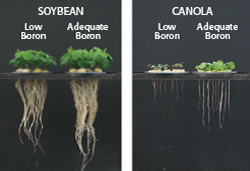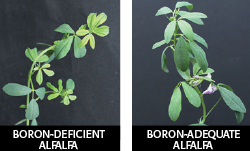Boron (B) is a micronutrient critical to the growth and health of all crops. It is a component of plant cell walls and reproductive structures. It is a mobile nutrient within the soil, meaning it is prone to movement within the soil. Because it is required in small amounts, it is important to deliver B as evenly as possible across the field. Traditional fertilizer blends containing B struggle to achieve uniform nutrient distribution. Despite the need for this critical nutrient, B is the second most widespread micronutrient deficiency problem worldwide after zinc.
Major Functions of Boron in Plants
Boron plays a key role in a diverse range of plant functions including cell wall formation and stability, maintenance of structural and functional integrity of biological membranes, movement of sugar or energy into growing parts of plants, and pollination and seed set. Adequate B is also required for effective nitrogen fixation and nodulation in legume crops.
Boron deficiency commonly results in empty pollen grains, poor pollen vitality and a reduced number of flowers per plant. Low B supply can also stunt root growth, as shown in the soybean and canola photos (see Picture 1).

Picture 1: Shoot and root growth of soybean and canola plants with low and adequate boron supply (courtesy: Y. Ceylan and I. Cakmak).
Plant Analysis for Boron
To determine a plant’s B nutrient status, younger leaves are recommended for sampling and analysis. Typically, adequate B levels in dried leaf tissues range from 25 to 75 ppm B, which is a considerable quantity for many crops. Generally, a soil application of B is recommended when leaves contain less than 25 ppm B in high-boron-demanding crops such as alfalfa, sugar beets, potatoes, sunflower, soybeans and canola.
Boron Deficiency Symptoms
Most crops are not able to mobilize B from vegetative tissues to actively growing, meristematic plant tissues such as shoots, root tips, flowers, seeds or fruits. Rather, B transport occurs primarily in the xylem channel, resulting from transpiration. Because of this, deficiency symptoms first develop in newly developed plant tissue such as young leaves and reproductive structures (see Picture 2).

Picture 2: Alfalfa plants grown with deficient (left) and adequate (right) supply of B fertilization (courtesy: A. Yazici and I. Cakmak).
Under severe B deficiency, stunted development and death of meristematic growing points are common. Other common reactions include reduced root elongation, failure of flowers to set seeds and fruit abortion. Low B supply may also adversely affect pollination and seed set, without visible leaf deficiency symptoms.
Soil Factors Affecting Boron Deficiency in Plants
Boron deficiency is highly prevalent in sandy acidic soils with low organic matter, due to the potential for B leaching. Soils with high adsorption and retention capacity (e.g., soils with high pH and rich in clay minerals and iron or aluminum oxides) are also commonly impacted by B deficiency.
In most crops, B shows very poor phloem mobility. Consequently, B in leaf tissue cannot be transported sufficiently into the reproductive organs (i.e., shoot tips, buds, flowers, seeds, etc.). Because of this poor mobility, keeping soluble B in soil solution during all stages of plant growth, particularly during reproductive growth (e.g., during seed setting), is critical for optimal plant nutrition.
Environmental Factors Affecting Boron Deficiency
Environmental factors that reduce transpiration, such as high air humidity and low soil moisture, have adverse impacts on xylem transportation of B. Extended periods of drought impede B uptake by reducing root growth, limiting supply of B from organic matter reserves, and by depressing diffusion and transport of B to root surfaces. Plants under low B supply are more susceptible to damage from high light intensity associated with long and hot, sunny days (see Picture 3). Under B deficiency, use of absorbed light energy in photosynthesis is significantly reduced, leading to an excess amount of energy and potential for leaf damage. Low soil temperature can also reduce root boron uptake.

Picture 3: Growth of sunflower plants with sufficient and deficient boron supply under low and high light conditions. Plants under low boron supply are quickly damaged when exposed to high light intensity (courtesy of I. Cakmak; see also Cakmak and Römheld, 1997, Plant Soil, 193:71–83).
Sufficient Boron for Better Root Uptake of Phosphorus and Potassium
Studies show that adequate B nutrition improves root uptake of phosphorus (P) and potassium (K) by maintaining proper function (through ATPase activity) and structure of root cell membranes. Boron has an important role in colonization of roots with mycorrhizal fungi, which contributes to root uptake of P. In short-term experiments with corn plants, reduced root uptake of P and K under low B supply was restored within one hour after B was added to the growth medium. Experimental evidence also suggests that adequate B supply is needed for mitigation of aluminum toxicity in plants grown in low-pH soils.
Tips for Preventing Boron Deficiency
Soil-test your fields every two years to gain a thorough understanding of the nutrient levels of your field. Make sure to compare your yield goals with current nutrient needs, and discuss options with an agronomist. Because there is a fine line between deficiency and toxicity, it’s important to apply the correct amount of B at the right rate using the right source. Aspire® with Boron ensures uniform nutrient distribution across each field. Using Nutriform® technology, Aspire combines potassium and boron in each granule to help achieve balanced crop nutrition.
Further Readings
Brown PH, et al. 2002: Boron in plant biology. Plant Biology, 4:205–223.
Cakmak I. and Römheld V. 1997: Boron deficiency-induced impairments of cellular functions in plants. Plant Soil, 193:71–83.
Dear BS and Weir RG. 2004: Boron deficiency in pastures and field crops. New South Wales Department of Agriculture AgFacts, P1.AC.1, 2nd Ed.
Marschner P. 2012: Marschner’s Mineral Nutrition of Higher Plants, 3rd Ed. Academic Press.